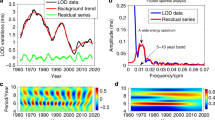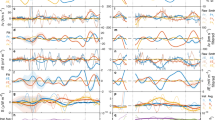Abstract
Geomagnetic jerks are abrupt changes in the second time derivative—the secular acceleration—of Earth’s magnetic field that punctuate ground observatory records. As their dynamical origin has not yet been established, they represent a major obstacle to the prediction of geomagnetic field behaviour for years to decades ahead. Recent jerks have been linked to short-lived, temporally alternating and equatorially localized pulses of secular acceleration observed in satellite data, associated with rapidly alternating flows at Earth’s core surface. Here we show that these signatures can be reproduced in numerical simulations of the geodynamo that realistically account for the interaction between slow core convection and rapid hydromagnetic waves. In these simulations, jerks are caused by the arrival of localized Alfvén wave packets radiated from sudden buoyancy releases inside the core. As they reach the core surface, the waves focus their energy towards the equatorial plane and along lines of strong magnetic flux, creating sharp interannual changes in core flow and producing geomagnetic jerks through the induced variations in magnetic field acceleration. The ability to numerically reproduce jerks offers a new way to probe the physical properties of Earth’s deep interior.
This is a preview of subscription content, access via your institution
Access options
Access Nature and 54 other Nature Portfolio journals
Get Nature+, our best-value online-access subscription
$29.99 / 30 days
cancel any time
Subscribe to this journal
Receive 12 print issues and online access
$259.00 per year
only $21.58 per issue
Buy this article
- Purchase on Springer Link
- Instant access to full article PDF
Prices may be subject to local taxes which are calculated during checkout




Similar content being viewed by others
Data availability
The data that support the findings of this study are available from the corresponding author on request.
Code availability
The numerical simulation code used to generate the results of this study is available from the corresponding author on request.
References
Brown, W., Mound, J. & Livermore, P. Jerks abound: an analysis of geomagnetic observatory data from 1957 to 2008. Phys. Earth Planet. Int. 223, 62–76 (2013).
Courtillot, V., Ducruix, J. & Le Mouël, J.-L. Sur une accélération récente de la variation séculaire du champ magnétique terrestre. C. R. Acad. Sci. Paris D 287, 1095–1098 (1978).
Malin, S. R. C., Hodder, B. M. & Barraclough, D. R. in Scientific Contributions in Commemoration of Ebro Observatory’s 75th Anniversary (ed. Cardús, J. O.) 239–256 (Observatorio Del Ebro, 1983).
Lesur, V., Wardinski, I., Hamoudi, M. & Rother, M. The second generation of the GFZ reference internal magnetic model: GRIMM-2. Earth Planets Space 62, 765–773 (2010).
Finlay, C. C., Olsen, N., Kotsiaros, S., Gillet, N. & Tøffner-Clausen, L. Recent geomagnetic secular variation from Swarm and ground observatories as estimated in the CHAOS-6 geomagnetic field model. Earth Planets Space 68, 112 (2016).
Olsen, N., Mandea, M., Sabaka, T. J. & Tøffner-Clausen, L. CHAOS-2—a geomagnetic field model derived from one decade of continuous satellite data. Geophys. J. Int. 179, 1477–1487 (2009).
Chulliat, A. & Maus, S. Geomagnetic secular acceleration, jerks, and a localized standing wave at the core surface from 2000 to 2010. J. Geophys. Res. 119, 1531–1543 (2014).
Chulliat, A., Thebault, E. & Hulot, G. Core field acceleration pulse as a common cause of the 2003 and 2007 geomagnetic jerks. Geophys. Res. Lett. 37, L07301 (2010).
Chulliat, A., Alken, P. & Maus, S. Fast equatorial waves propagating at the top of the Earth’s core. Geophys. Res. Lett. 42, 3321–3329 (2015).
Torta, J. M., Pavón-Carrasco, F. J., Marsal, S. & Finlay, C. C. Evidence for a new geomagnetic jerk in 2014. Geophys. Res. Lett. 42, 7933–7940 (2015).
Braginsky, S. I. Short-period geomagnetic secular variation. Geophys. Astrophys. Fluid Dynam. 30, 1–78 (1984).
Bloxham, J., Zatman, S. & Dumberry, M. The origin of geomagnetic jerks. Nature 420, 65–68 (2002).
Gillet, N., Jault, D., Canet, E. & Fournier, A. Fast torsional waves and strong magnetic field within the Earth’s core. Nature 465, 74–77 (2010).
Wicht, J. & Christensen, U. R. Torsional oscillations in dynamo simulations. Geophys. J. Int. 181, 1367–1380 (2010).
Teed, R. J., Jones, C. A. & Tobias, S. M. The dynamics and excitation of torsional waves in geodynamo simulations. Geophys. J. Int. 196, 724–735 (2014).
Schaeffer, N., Jault, D., Nataf, H.-C. & Fournier, A. Turbulent geodynamo simulations: a leap towards Earth’s core. Geophys. J. Int. 211, 1–29 (2017).
Aubert, J., Gastine, T. & Fournier, A. Spherical convective dynamos in the rapidly rotating asymptotic regime. J. Fluid. Mech. 813, 558–593 (2017).
Aubert, J. Geomagnetic acceleration and rapid hydromagnetic wave dynamics in advanced numerical simulations of the geodynamo. Geophys. J. Int. 214, 531–547 (2018).
Cox, G., Livermore, P. & Mound, J. The observational signature of modelled torsional waves and comparison to geomagnetic jerks. Phys. Earth Planet. Int. 255, 50–65 (2016).
Wardinski, I., Holme, R., Asari, S. & Mandea, M. The 2003 geomagnetic jerk and its relation to the core surface flows. Earth Planet. Sci. Lett. 267, 468–481 (2008).
Silva, L. & Hulot, G. Investigating the 2003 geomagnetic jerk by simultaneous inversion of the secular variation and acceleration for both the core flow and its acceleration. Phys. Earth Planet. Int. 198–199, 28–50 (2012).
Gillet, N., Jault, D. & Finlay, C. C. Planetary gyre, time-dependent eddies, torsional waves and equatorial jets at the Earth’s core surface. J. Geophys. Res. 120, 3991–4013 (2015).
Dormy, E. & Mandea, M. Tracking geomagnetic impulses at the core–mantle boundary. Earth Planet. Sci. Lett. 237, 300–309 (2005).
Mandea, M. et al. Geomagnetic jerks: rapid core field variations and core dynamics. Space. Sci. Rev. 155, 147–175 (2010).
Aubert, J., Finlay, C. C. & Fournier, A. Bottom-up control of geomagnetic secular variation by the Earth’s inner core. Nature 502, 219–223 (2013).
Kloss, C. & Finlay, C. C. Time-dependent low-latitude core flow and geomagnetic field acceleration pulses. Geophys. J. Int. 217, 140–168 (2019).
Bardsley, O. P. & Davidson, P. A. Inertial–Alfvén waves as columnar helices in planetary cores. J. Fluid. Mech. 805, R2 (2016).
Dean, R. G. & Dalrymple, R. A. Water Wave Mechanics for Engineers and Scientists Vol. 2 (World Scientific, 1991).
Le Huy, M., Alexandrescu, M., Hulot, G. & Le Mouël, J.-L. On the characteristics of successive geomagnetic jerks. Earth Planets Space 50, 723–732 (1998).
Sabaka, T. J., Olsen, N. & Purucker, M. Extending comprehensive models of the Earth’s magnetic field with Oersted and CHAMP data. Geophys. J. Int. 159, 521–547 (2004).
Pinheiro, K. J., Jackson, A. & Finlay, C. C. Measurements and uncertainties of the occurrence time of the 1969, 1978, 1991, and 1999 geomagnetic jerks. Geochem. Geophys. Geosyst. 12, Q10015 (2011).
Pais, M. A., Alberto, P. & Pinheiro, F. J. G. Time-correlated patterns from spherical harmonic expansions: Application to geomagnetism. J. Geophys. Res. 120, 8012–8030 (2015).
Olsen, N. & Mandea, M. Rapidly changing flows in the Earth’s core. Nat. Geosci. 1, 390–394 (2008).
Gillet, N. in Geomagnetism, Aeronomy and Space Weather: A Journey from the Earth’s Core to the Sun (eds Mandea, M. et al.) Ch. 9 (International Association of Geomagnetism and Aeronomy, 2019).
Nakagawa, T. Effect of a stably stratified layer near the outer boundary in numerical simulations of a magnetohydrodynamic dynamo in a rotating spherical shell and its implications for Earth’s core. Phys. Earth Planet. Int. 187, 342–352 (2011).
Christensen, U. R. Geodynamo models with a stable layer and heterogeneous heat flow at the top of the core. Geophys. J. Int. 215, 1338–1351 (2018).
Holme, R. & de Viron, O. Geomagnetic jerks and a high-resolution length-of-day profile for core studies. Geophys. J. Int. 160, 435–439 (2005).
Lesur, V., Whaler, K. & Wardinski, I. Are geomagnetic data consistent with stably stratified flow at the core–mantle boundary? Geophys. J. Int. 201, 929–946 (2015).
Schaeffer, N. & Jault, D. Electrical conductivity of the lowermost mantle explains absorption of core torsional waves at the equator. Geophys. Res. Lett. 43, 4922–4928 (2016).
Holme, R. & de Viron, O. Characterization and implications of intradecadal variations in length of day. Nature 499, 202–204 (2013).
Fournier, A. et al. An Introduction to data assimilation and predictability in geomagnetism. Space Sci. Rev. 155, 247–291 (2010).
Aubert, J. Geomagnetic forecasts driven by thermal wind dynamics in the Earth’s core. Geophys. J. Int. 203, 1738–1751 (2015).
Fournier, A., Aubert, J. & Thébault, E. A candidate secular variation model for IGRF-12 based on Swarm data and inverse geodynamo modelling. Earth Planets Space 67, 81 (2015).
Thébault, E. et al. International geomagnetic reference field: the twelfth generation. Earth Planets Space 67, 79 (2015).
Pichon, G., Aubert, J. & Fournier, A. Coupled dynamics of Earth’s geomagnetic westward drift and inner core super-rotation. Earth Planet. Sci. Lett. 437, 114–126 (2016).
Buffett, B. A. Geomagnetic fluctuations reveal stable stratification at the top of the Earth’s core. Nature 507, 484–487 (2014).
Christensen, U. R., Wardinski, I. & Lesur, V. Timescales of geomagnetic secular acceleration in satellite field models and geodynamo models. Geophys. J. Int. 190, 243–254 (2012).
Schaeffer, N. Efficient spherical harmonic transforms aimed at pseudospectral numerical simulations. Geophys. Geochem. Geosyst. 14, 751–758 (2013).
Acknowledgements
J.A. acknowledges support from the French Programme National de Planétologie of CNRS/INSU, and from the Fondation Simone et Cino Del Duca of Institut de France (2017 research grant). This work was granted access to the HPC resources of S-CAPAD, IPGP, France, and to the HPC resources of IDRIS, CINES and TGCC under allocations A0020402122 and A0040402122 from GENCI. The results presented in this work rely on data collected at magnetic observatories. The authors thank the national institutes that support them and INTERMAGNET for promoting high standards of magnetic observatory practice (www.intermagnet.org). This is IPGP contribution 4011.
Author information
Authors and Affiliations
Contributions
J.A. designed the project, designed and carried out the numerical experiments and wrote the manuscript. C.C.F. processed the geomagnetic data, constructed the CHAOS-6x5 geomagnetic field model and led its comparison with the simulation results. J.A. and C.C.F. processed the results and discussed the manuscript.
Corresponding author
Ethics declarations
Competing interests
The authors declare no competing interests.
Additional information
Publisher’s note: Springer Nature remains neutral with regard to jurisdictional claims in published maps and institutional affiliations.
Supplementary information
Supplementary Information
Supplementary Figs, Tables and references
Supplementary Video 1
Hammer projection of the core surface radial secular geomagnetic acceleration the CHAOS-6x5 geomagnetic field model filtered at spherical harmonic degree 9 from 1999 to 2018.
Supplementary Video 2
Hammer projection of the core surface radial secular geomagnetic acceleration from the Midpath model, filtered at spherical harmonic degree 9, in the vicinity of the jerk event occurring at 0 yr.
Supplementary Video 3
Hammer projection of the core surface azimuthal flow acceleration (blue is westwards) from the Midpath model, in the vicinity of the jerk event occurring at time 0 yr.
Supplementary Video 4
Partial equatorial cut and meridional cut outside the tangent cylinder of the convective density anomaly (orange denotes lighter fluid) from the Midpath model in the vicinity of the jerk event occurring at time 0 yr.
Supplementary Video 5
Partial equatorial cut and meridional cut outside the tangent cylinder of azimuthal flow acceleration (blue is westwards) from the Midpath model in the vicinity of the jerk event occurring at time 0 yr.
Rights and permissions
About this article
Cite this article
Aubert, J., Finlay, C.C. Geomagnetic jerks and rapid hydromagnetic waves focusing at Earth’s core surface. Nat. Geosci. 12, 393–398 (2019). https://doi.org/10.1038/s41561-019-0355-1
Received:
Accepted:
Published:
Issue Date:
DOI: https://doi.org/10.1038/s41561-019-0355-1
This article is cited by
-
Gyres, jets and waves in the Earth’s core
Nature Reviews Earth & Environment (2023)
-
Sustaining Earth’s magnetic dynamo
Nature Reviews Earth & Environment (2022)
-
Waves in planetary dynamos
Reviews of Modern Plasma Physics (2022)
-
Earth’s Rotation: Observations and Relation to Deep Interior
Surveys in Geophysics (2022)
-
A Dynamical Prospective on Interannual Geomagnetic Field Changes
Surveys in Geophysics (2022)



